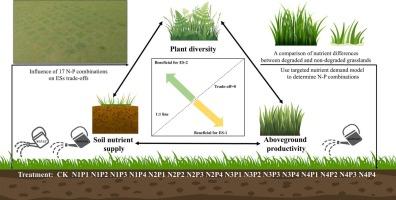Targeted nutrient addition reduces the trade-offs between ecosystem services in degraded grasslands
IF 4.1
2区 环境科学与生态学
Q1 ECOLOGY
引用次数: 0
Abstract
Nutrient addition is widely applied in degraded grassland restoration and significantly affects ecosystem services (ESs). However, traditional nutrient addition methods mostly rely on empirical values or agricultural models, lacking precision strategies that are tailored to grassland ecosystem characteristics, and often exacerbate trade-offs between aboveground productivity (AGP), soil nutrient supply (SNS), and plant diversity (PD). Using non-degraded grassland as a reference, this study calculated the difference between plant nutrient demand and soil available nutrient supply, and for the first time constructed a targeted nutrient demand model applicable to grassland ecosystems. This study conducted experiments on degraded grasslands in Hulunbuir, Inner Mongolia, using a targeted nutrient demand model to determine nitrogen (N) and phosphorus (P) application amounts. The differences and trade-offs between AGP, SNS, and PD were quantified using the Entropy Weight Method (EWM) and Root Mean Square Deviation (RMSD), respectively. Results showed: (1) Under different nutrient addition treatments, SNS scores consistently exceeded those of AGP and PD, with the N4P3 treatment showing the highest overall ES capacity, significantly higher than the control (CK) (p < 0.05). (2) Targeted nutrient addition can shift the ES relationships from trade-offs to synergies. When the external N and P additions were insufficient (2.7–3.6 g N m−2, 0.12–0.15 g P m−2) or imbalanced N:P ratios were applied (10.8 g N m−2, 0.12 g P m−2), the trade-off relationships between ESs were similar to CK, predominantly showing moderate trade-offs (RMSD >0.1). Conversely, when appropriate nutrient additions were chosen (5.4–10.8 g N m−2, 0.23–0.46 g P m−2), the trade-off relationships between two pairs or overall ESs were mildly synergistic (RMSD <0.1). (3) The trade-off relationships between AGP and PD, SNS, as well as soil total nitrogen, are key factors influencing the overall trade-offs of ESs. In conclusion, this study represents the first adaptation of agricultural precision fertilization models to grassland ecosystems, identifying nutrient allocation thresholds that reduce trade-offs in ESs, enhancing the overall function of grassland ecosystems, and providing a scientific basis for precision nutrient application in degraded grasslands.

有针对性的养分添加减少了退化草原生态系统服务之间的权衡
养分添加在退化草地恢复中应用广泛,对生态系统服务功能有显著影响。然而,传统的养分添加方法大多依赖于经验值或农业模型,缺乏针对草地生态系统特征的精确策略,往往加剧了地上生产力(AGP)、土壤养分供应(SNS)和植物多样性(PD)之间的权衡。本研究以未退化草地为参照,计算植物养分需求与土壤速效养分供给的差值,首次构建了适用于草地生态系统的定向养分需求模型。本研究以内蒙古呼伦贝尔退化草原为研究对象,采用定向养分需求模型确定氮(N)和磷(P)施用量。分别采用熵权法(EWM)和均方根偏差(RMSD)对AGP、SNS和PD之间的差异和权衡进行量化。结果表明:(1)在不同营养添加处理下,SNS得分均高于AGP和PD,其中N4P3处理的ES总容量最高,显著高于对照(CK) (p <;0.05)。(2)有针对性的营养添加可以将ES关系从权衡转向协同。当外源N和P添加量不足(2.7-3.6 g N m−2,0.12 - 0.15 g P m−2)或N:P比例不平衡(10.8 g N m−2,0.12 g P m−2)时,ESs之间的权衡关系与对照相似,主要表现为适度权衡(RMSD >0.1)。相反,当选择适当的营养添加量(5.4-10.8 g N m−2,0.23-0.46 g P m−2)时,两对或总ESs之间的权衡关系是温和的协同关系(RMSD <0.1)。(3) AGP与PD、SNS以及土壤全氮之间的权衡关系是影响ESs整体权衡的关键因素。综上所述,本研究首次将农业精准施肥模型应用于草地生态系统,确定了减少生态系统权衡的养分分配阈值,增强了草地生态系统的整体功能,为退化草地的精准施肥提供了科学依据。
本文章由计算机程序翻译,如有差异,请以英文原文为准。
求助全文
约1分钟内获得全文
求助全文
来源期刊

Ecological Engineering
环境科学-工程:环境
CiteScore
8.00
自引率
5.30%
发文量
293
审稿时长
57 days
期刊介绍:
Ecological engineering has been defined as the design of ecosystems for the mutual benefit of humans and nature. The journal is meant for ecologists who, because of their research interests or occupation, are involved in designing, monitoring, or restoring ecosystems, and can serve as a bridge between ecologists and engineers.
Specific topics covered in the journal include: habitat reconstruction; ecotechnology; synthetic ecology; bioengineering; restoration ecology; ecology conservation; ecosystem rehabilitation; stream and river restoration; reclamation ecology; non-renewable resource conservation. Descriptions of specific applications of ecological engineering are acceptable only when situated within context of adding novelty to current research and emphasizing ecosystem restoration. We do not accept purely descriptive reports on ecosystem structures (such as vegetation surveys), purely physical assessment of materials that can be used for ecological restoration, small-model studies carried out in the laboratory or greenhouse with artificial (waste)water or crop studies, or case studies on conventional wastewater treatment and eutrophication that do not offer an ecosystem restoration approach within the paper.
 求助内容:
求助内容: 应助结果提醒方式:
应助结果提醒方式:


